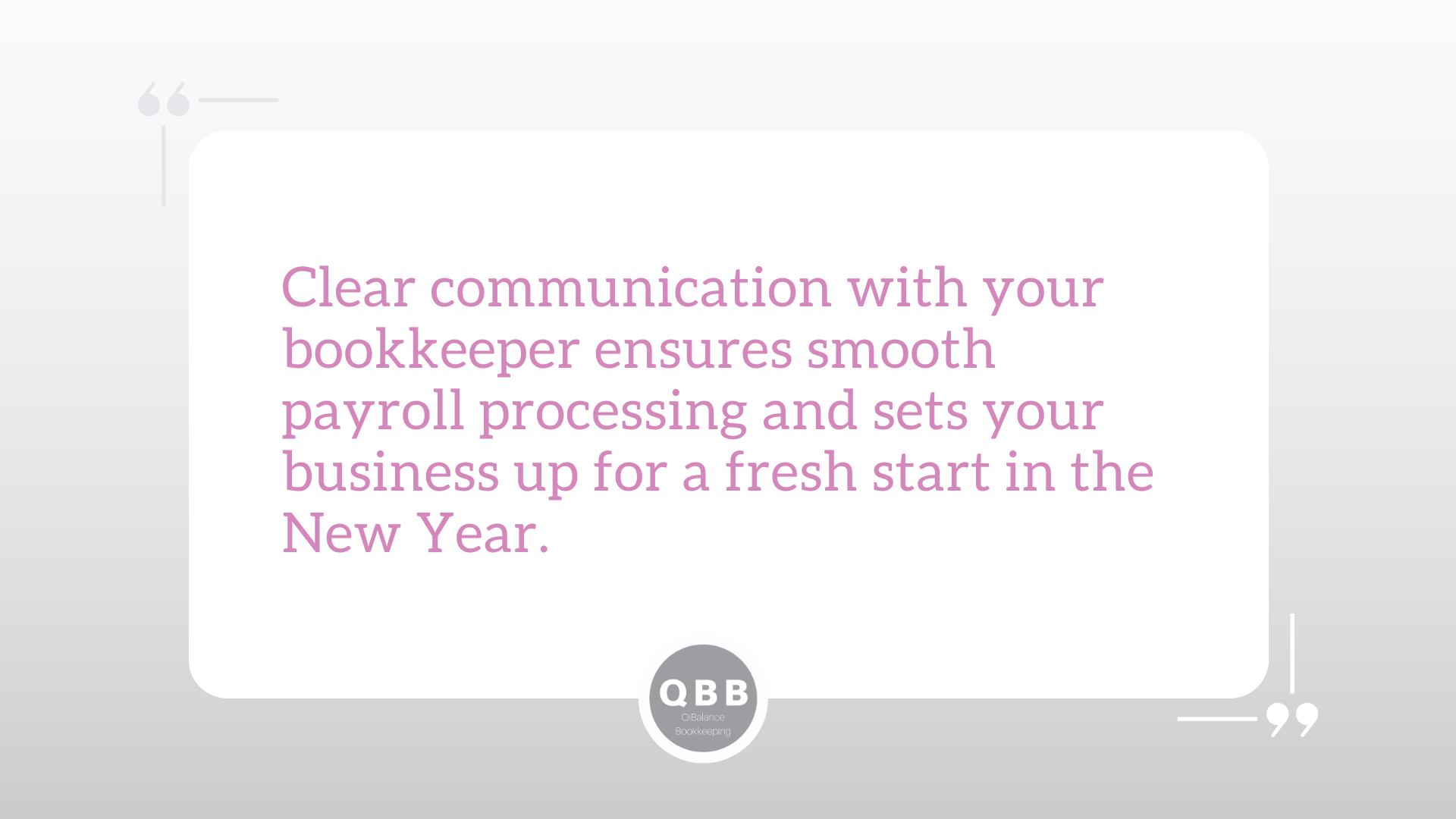Preparing for the Annual Business Shutdown
/As the New Year approaches, the season is one filled with joy, celebration, and family gatherings. Yet, for small business owners whose businesses have employees, the festive period also brings unique responsibilities – especially when it comes to supporting bookkeepers in managing the payroll tasks associated with an annual shutdown.
Want to stay in the loop with my regular newsletter?
Each month I share business, bookkeeping, and QiBalance updates.
During the holidays, diverse work arrangements and employee leave schedules can create complexities. Some staff are gearing up for annual vacations, others may stay on to keep operations running, and there are those with limited leave who may face challenges working around holiday schedules. Your bookkeeper plays an important role in ensuring smooth payroll processing, accurate leave tracking, and ensuring your business maintains regulatory compliance.
To ease the holiday workload, small business owners can work alongside their bookkeeper to confirm any special requirements, leave policies, and deadlines. Providing necessary documentation well in advance, communicating clearly with your team about holiday expectations, and encouraging everyone to plan for potential closures will streamline the operation. QiBalance Bookkeeping can help clients with annual shutdown planning and answer related shutdown and payroll concerns – please get in touch with us if you would like additional support through this process.
By providing bookkeepers with timely information and a clear schedule, business owners can help make this season run smoothly for everyone involved and will help to set the stage for a fresh start in the New Year.
What is a Shutdown?
According to the Fair Work Ombudsman, a ‘shutdown’ or ‘close down’ is when a business temporarily closes during a specific period. It may be that it is not viable for the business to operate during this period because it is a quiet time, or many staff may be away on leave.
The complexity comes when working with varying awards or working conditions, as well as when there is a combination of people going on leave, some remaining at work, some that have no leave, and those who want to work but cannot.
| A shutdown is not the same as a stand down. A stand down can occur when employees cannot be usefully employed due to various circumstances, including stoppage of work for reasons that the employer cannot reasonably be held responsible for. |
Shutdown Payments Explained
Recent updates to awards (as of May 2023) mean that small business owners must carefully follow new regulations when planning a holiday shutdown. Below is a guide on how these rules impact employee payment and leave during this period:
· Annual Leave Requirement: You may require employees to take paid leave during a shutdown. You must provide at least 28 days written notice to all impacted employees. The notice period can be reduced through an agreement between the employer and the majority of impacted employees.
· Reasonable: The requirement to take annual leave must be reasonable.
· Options for Insufficient Leave: If employees do not have enough leave, you can agree on alternatives such as accrued time off, leave in advance, or unpaid leave. These agreements must be in writing.
· Pay During Shutdown: Full-time and part-time employees must be paid if they take leave during the shutdown, while casuals are not paid for this time as they are paid only for hours worked.
· Follow Your Award or Agreement: Some awards allow requiring leave during a shutdown, while others allow only requests. If the award does not specify then the employees cannot be forced to take leave or go unpaid without an agreement.
· If Leave is Insufficient and No Agreement: If an employee lacks leave and does not agree to unpaid leave or leave in advance, they are entitled to their usual wages.
Public Holidays
Public holidays impact employee pay and leave, especially during shutdowns.
Public Holidays During Annual Leave
If a public holiday falls during an employee’s annual leave, it is treated as a regular public holiday, not as part of their leave. The employee will be paid for the holiday as if they had worked that day, and their annual leave balance will not be affected.
Example: If Mary, a full-time employee, is on annual leave for 7 days, including New Years Day (a public holiday), she will be paid for New Years Day separately, using only 6 days of her leave.
Public Holiday Pay and Sick Leave
If an employee takes sick leave around a public holiday, they are still entitled to public holiday pay, provided it is a day they would typically work.
If an employee is rostered to work on a public holiday but calls in sick, they will not receive public holiday pay unless they are on paid leave.
Employees Working on Public Holidays
Employees who work on a public holiday are entitled to their base pay plus any additional entitlements as specified in their award or agreement. This may include:
· Public holiday penalty rates
· Extra day off or additional annual leave
· Minimum shift length (e.g. 4 hours)
· Agreement to substitute another day for the public holiday
While employees cannot be forced to work on a public holiday, employers can request it if reasonable, considering factors like the employee’s family responsibilities, pay rates, business needs, and their typical work schedule.
Employees Not Working on Public Holidays
Employees (except casuals) who would usually work on a public holiday must be paid their base rate for that day. This rate does not include penalty rates, loadings, overtime, allowances, or bonuses.
You cannot change an employee’s schedule to avoid paying for a public holiday.
Example: If Steven is a part-time employee who only works Tuesday to Thursday, and New Years Day falls on a Monday, he is not entitled to public holiday pay because Monday is not a regular workday for him.
Tips to Assist Your Bookkeeper
If you are a small business owner with a payroll, preparing for a holiday shutdown requires planning to ensure that your bookkeeper has access to accurate, timely information and that your employees have a smooth break in compliance with regulatory requirements.
Remember to:
· Notify Employees of the Shutdown
Give all employees at least four weeks’ notice of the planned shutdown dates. This advance notice helps employees plan their leave and allows your bookkeeper to begin preparing payroll accordingly.
· Collect Leave Confirmations
Ask employees to confirm their leave plans for the shutdown period. Work with your bookkeeper to ensure all necessary forms are completed and submitted, clarifying leave dates, intentions, and any special considerations.
· Account for Public Holidays
Review the calendar with your bookkeeper to ensure that you are aware of public holidays during the shutdown. Your bookkeeper will include the public holidays in your payroll and ensure that your employees receive the correct entitlements.
· Determine Work Schedules During Shutdown
Confirm if any employees will be working during the shutdown or on a public holiday. Communicate any special pay rates, penalty rates, or adjustments that will apply. Ask your bookkeeper to clarify this for you if you are unsure. Clear communication helps prevent misunderstandings and reduces payroll issues.
· Plan the Pay Schedule
Decide when leave payments will be made: during the pay cycle, before Christmas, or at another agreed time. Review this plan with your bookkeeper so they can manage payroll and ensure employees know what to expect.
· Prepare for the Shutdown Pay Run
If a pay run falls within the shutdown period, let your bookkeeper know about any specific instructions or changes. Be aware that holiday processing can take longer, so allowing extra time for the pay run can help ensure it is completed smoothly and on time.
· Communicate and Collaborate with Your Bookkeeper
Maintain open communication with your bookkeeper throughout the shutdown planning. Ensure they have the information they need to process leave, adjust payroll, and finalise end-of-calendar-year tasks.
Following these steps will help keep employees informed, help your bookkeeper complete your payroll effectively, and help to ensure a successful transition into the New Year.
If you would like support with your business shutdown planning and payroll, or if you have any related questions, be sure to contact QiBalance Bookkeeping.



